How To Create A Budget In Clarity Money
Ultimate Guide to Creating a Budget
"Budget." The ugly B word. Just like how nobody likes to count calories, most people don't enjoy budgeting. For starters, there are a swarm of negative connotations associated with "budgeting." For instance, feeling restricted, being a "no fun" boring person, or forgoing the joy of the here and now with saving for retirement.
Instead, try thinking of it as a spending plan. That's all a budget really is: A game plan for spending and saving your money. It'll help make sure your financial bases are covered, help you steer clear of debt or manage existing debt, and help you stay on track with your money goals.
Without a spending plan of sorts, you run the risk of having those "amnesiac-like" moments where you don't know exactly where your last paycheck went, or not having enough money to cover a month's worth of living expenses.
In this guide, we'll show you exactly how to create a budget, and a handful of ways to stick to one.
Start with your "why"
You most likely won't want to start a budget—and aren't likely to stick to one—without knowing your reasons for doing so. Maybe you've been a little reckless with your spending and want to reign in your impulse buys. Or perhaps you're on a debt repayment plan, and are determined to knock out your credit card debt as quickly as possible. Or it could be that while you're generally good with your money, you're not making great headway on some of your long-term goals, such as buying a house or paying off your student loans.
Whatever your reason, starting with having a crystal-clear reason for why you want to go through the initial work and trouble of creating a budget will give you focus and help you follow through.
So before you start building a budget, ask yourself, "Why am I doing this?" And keep in mind, the deeper you go, the more effective your reasons will be. For example: "I want to become debt-free" is a good reason to budget. But why do you want to become debt-free?
"I want to become debt-free so I never have to experience the anxiety and stress of living paycheck to paycheck ever again," is an even better reason.
When you're looking for your why, don't stop at the surface layer. Dig deeper. Think of all the slightly hidden motivations that brought you to this point. When you connect those feelings and desires to the budgeting process, you'll find it's much easier to stick to the plan.
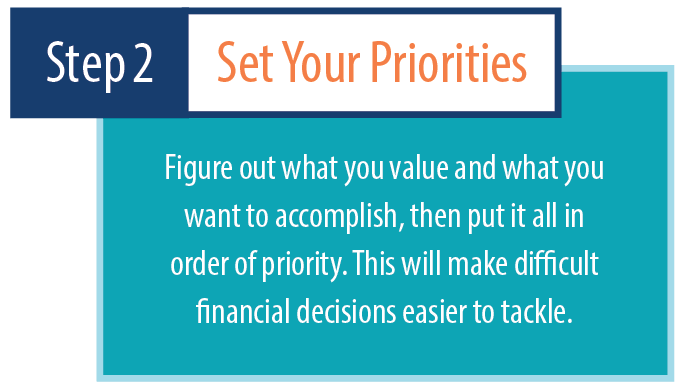
Figure out your priorities
Budgeting isn't just about numbers and math. It's about living your best life by improving your relationship with money. It's figuring out what's important to you, and then syncing up your spending and saving habits to your values and goals. And you can't better your relationship with money without knowing where your money is going.
If you're juggling a bunch of different money goals, jot them all down. Yup, every single one of them. Then, focus on the top few priorities. For instance, you may want to have some more free time to work on your creative pursuits, or to spend time with family. Or you and your partner would like to travel more. If you're married, you and your spouse may want to buy a home in a few years. Saddled with a heavy debt load? Whether it's in the form of student loans, credit card debt, or a car loan, you may want to get it paid off within a few years time.
The most important thing when determining priorities is honesty. When your priorities are dishonest and don't truly reflect your personal values, you're going to feel conflicted when making important decisions and may find it hard to stay motivated and on task.
Don't shy away from the real you when it comes to budgeting.
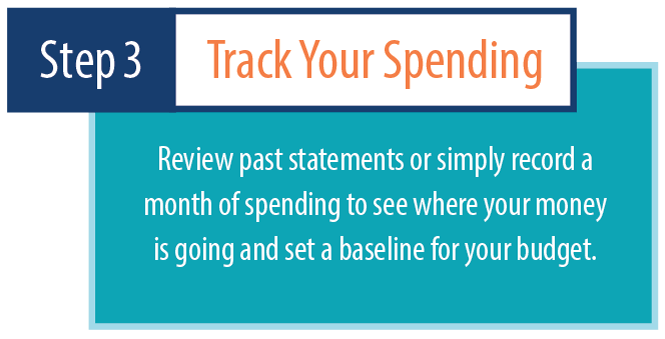
Watch your money
The easiest way to start building a budget is to first understand what you're currently spending.
To figure out exactly where your money is going, you'll want to monitor your outflow. It's helpful do this before and after you create a budget. That's because you may not know exactly how much to allocate toward groceries without knowing how much you roughly spend in a given month. And you'll also want to track your spending after you've created a budget, so you can make tweaks accordingly.
This isn't as hard as it sounds. Long gone are the days when you have to balance everything with a checkbook. You can track your spending by checking recent bank or credit card transactions. There are also a handful of money management apps that show your day-to-day transactions.
The beauty of tracking your spending online is that many apps and services let you break up your spending into categories. With a few clicks of a button, you can see how much you spent on groceries or gas within a given month or in the last year.
Not technically inclined? No worries. You can get the job done with a pencil and a notebook just as well. Just find the method that suits you!
Download: Daily Expenditure worksheet
What you discover may surprise you. You may find that while you feel cash-strapped at the end of each month, you actually make more than enough to cover your living expenses and save for an emergency fund. Or that while you claim to be a health-food nut, you spend more money on fast food and takeaway than you'd like to admit.
Knowing where you stand will help you figure out where you want to head next. So if you find out you're making enough to save each month, you might want to see where you can cut back so you start that emergency fund.
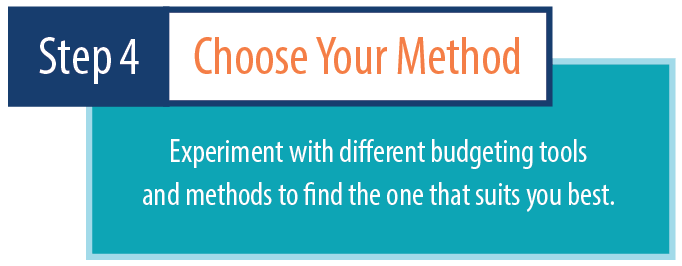
Find the right budgeting style for you
There are no shortages of ways you can approach budgeting. Some are very simple and bare-bones, others are more complex and detailed. No method is more "right" than any other. You simply want to find the method that best matches your personality and goals.
A few of the more popular ones include:
50/30/20 Budgeting Rule
Budgeting Style: Loose; big picture, no fine details
With the 50/30/20 rule, 50 percent of your take-home pay goes toward your "needs," for instance, such as housing, utilities, groceries, insurance, and your debts. So if your after-tax income is $3,000 each month, no more than $1,500 should go toward these "needs."
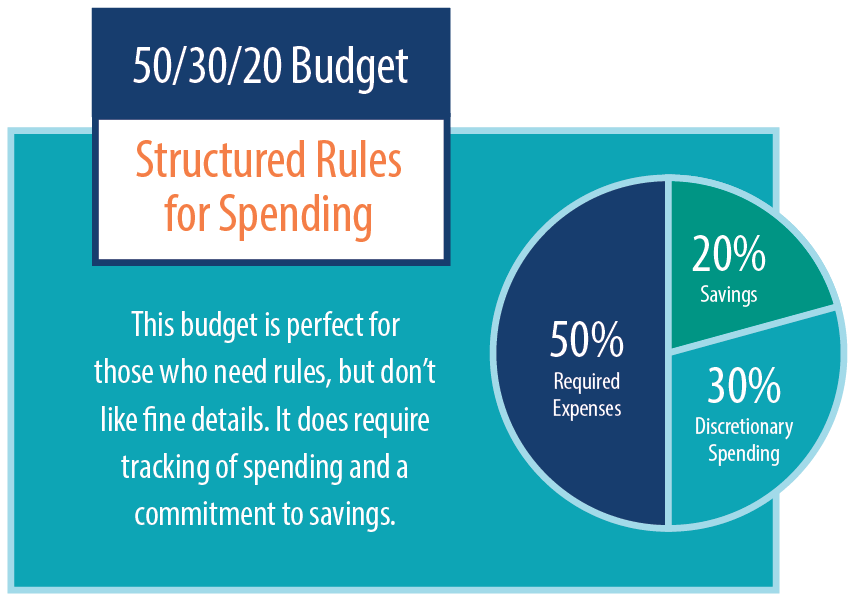
Next, 30 percent should go toward "wants," or discretionary income. Back to the $3,000 budget, no more than $900 should go toward wants. This includes anything you could do without, but makes your life richer and more enjoyable.
The remaining 20 percent (or $600) of your take-home pay would go toward your savings. This could include anything from saving for that nest egg for retirement, putting money into investments, or working toward goals such as saving for a car, a house, your children's college fund, or a dream vacation.
While some needs may be obvious, (i.e., rent, utilities) figuring out if something is a true "need" versus a "want" could be a bit murky. For instance, clothes for work could be classified as a "need," while going-out attire could go under "want."
And while you may need a monthly subscription to service to back up your files to the cloud, you may "want" a subscription to a music streaming service. As long as you categorize your "wants" and "needs" accordingly (and consistently), you can stay on track.
Zero-Sum Budget
Budgeting Style: Detail oriented; every dollar has a destination
With the zero-sum budget, every dollar that comes in is assigned a "job." The amount of money that's coming in plus the amount that's going out needs to equal zero.
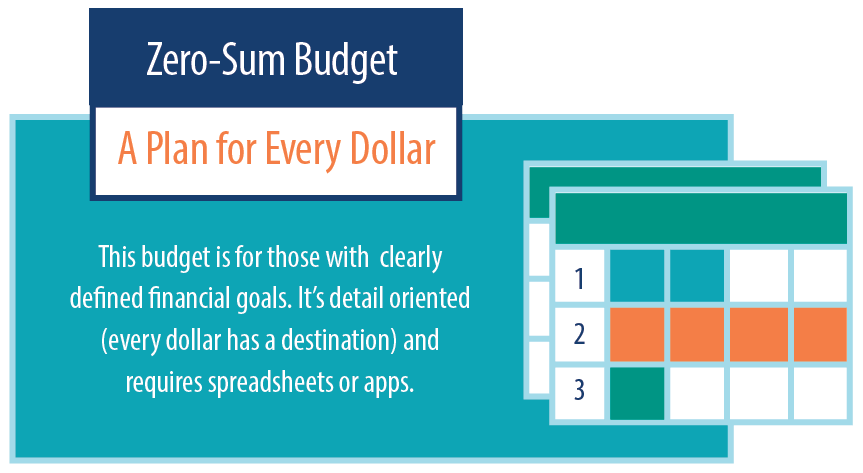
So if you bring home $3,000 in take-home pay each month, figure out where that money will go. You'll want to break up your spending into different categories: for instance, rent/utilities, car-related expenses, groceries, eating out, personal items, insurance, debt, and so forth. Let's say you've got all your expenses covered and have $200 "left over." You'll need to assign a task to those remaining two hundred buckaroos.
The value of the zero-sum budget is that it leaves nothing up in the air. Every dollar is accounted for and is used the way you planned.
The best way to approach a zero-sum budget is to write it all down. Figure out your anticipated income before the start of the month, then plan out where those dollars will go, adjusting for "reality" as you progress.
Anti-Budget
Budgeting Style: Minimalist; use priorities to pay as you go
Contrary to what the name suggests, this still is a spending plan of sorts. With the "anti-budget" you don't worry about specific categories. You simply pay as you go. There are only two catches - you have to pay your priorities first, and you need to make yourself the top priority.

In other words, start by saving. Then you spend the remainder. That's right. No quibbling over whether you went over your spending limit on groceries for the month, or feeling bad for spending more than you budgeted for clothing.
Just set your priorities (necessities like rent and bills first, wants second), then spend what you have in that order. Once you've set aside money for savings and covered your required bills and debts, you let your priorities dictate how you spend what's left. It's great for those who don't want to track their expenses on such a nitty-gritty level.
Money Flow
Budgeting Style: Automated; effort upfront, minimal maintenance
This requires a little bit more work and some trial-and-error, but after you've created a money flow and respective money buckets, you can pretty much set it and forget it. Once you figure out how much you need each month to cover all your expenses, you can then create a money flow. How does it work? The best approach is to figure out all of your recurring expenses and set up auto-pay for each. This should include fixed necessities like rent and utilities, but also things like cable and Netflix. Ideally, you pay these expenses directly from your checking account, so money flows in on payday and out when the bills are due, and you don't have to touch any of it.
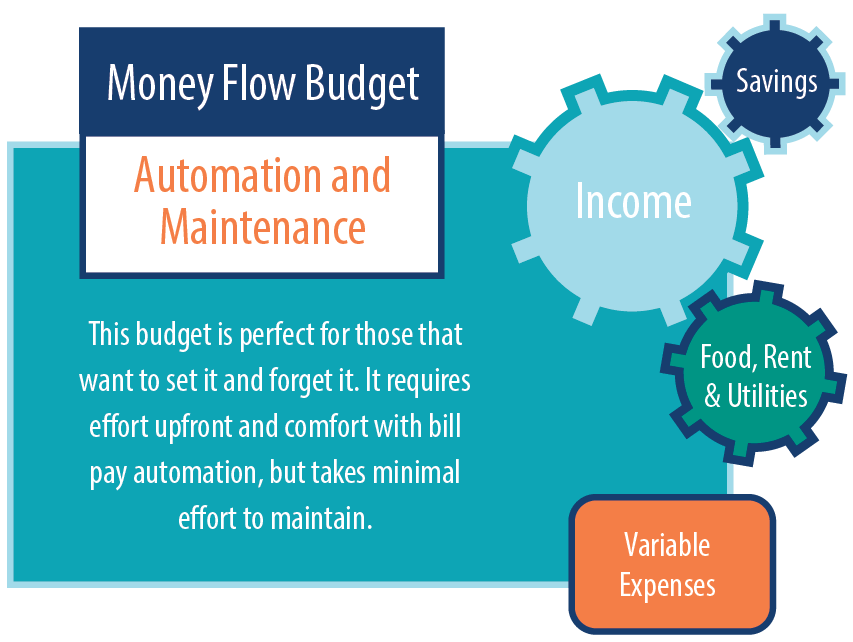
Next, you take the rest of your available income and budget that. Basically, this means you only need to track and monitor your variable and discretionary spending, like groceries, entertainment, gas for the car, etc. If it's easier, you can move this money to another account or debit card to create separation between your fixed auto-pay account and your discretionary/variable account. Better yet, if you're good at self-monitoring and not spending money you don't have, you can use a credit card to manage your variable expenses - just make sure you pay the balance in full at the end of the month.
You'll still want to review your spending regularly and adjust if you don't feel like you're making progress on your goals. In the ideal version of the Money Flow system, you do less month-to-month work, but you're always aware of what's happening with your money. Just because it's largely automated doesn't mean you can stop paying attention.
Which budget approach is right for you? Well, there's certainly no one-size-fits-all answer. Your approach depends on how you work best, and how much work and detail you want to put in to a budget. The important thing is that you make it a priority to create a spending plan.
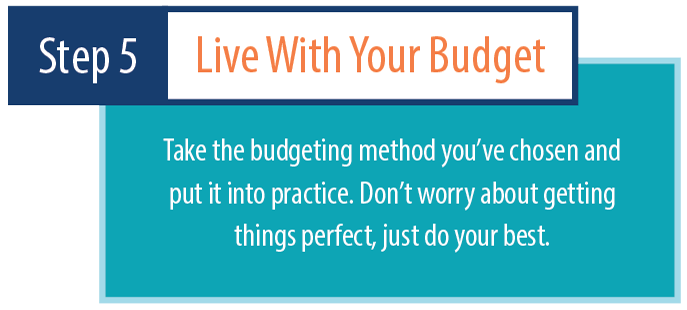
Use your budget
A budget is pretty useless if you don't actually use it. Once you've decided on a method that feels right to you, try it out. Personal finance is a lot of trial and error, so don't worry if your first attempt at budgeting doesn't feel quite right.
While you're refining your budget, here are a few helpful tools of the trade to consider.
Create a Spreadsheet
No matter what method you choose, it's important to put pen to paper (literally or figuratively, depending on your preferences) and actually write down the numbers. While this may seem old-fashioned, creating a basic spreadsheet is an incredibly effective starting point for almost all forms of budgeting.
You start by tallying up your expenses and how much you would like to spend for each category. Next, you note how much you actually spent in each category. This can seem a little time-consuming at the outset, but it can be pretty sobering to see some real numbers.
The Internet is loaded with handy budgeting spreadsheet templates. Grab one that looks good and go for it.
Download: Income & Expense worksheet
Make Use of Digital Tools
Note: This section is presented for informational purposes only. MMI isn't affiliated with any of these apps.
If you're comfortable using third party tools to manage your money, there are plenty of excellent apps out there to help you track your spending and create a budget. They include:
Mint: Founded in 2006, Mint is one of the most well known money management apps out there. It's an all-in-one free money management app where you can track all your spending, from bills to everyday transactions, create a simple budget, and set alerts on your spending. Mint creates a weekly summary so you can see exactly where your money went. Plus, you can check your credit score.
Clarity Money: Similar to Mint, Clarity Money is another excellent free money management tool. You can track your spending and see where your top spending categories are. You can also easily see how much you spent on X in a given year and automate your savings goals. Clarity Money can also help spot subscriptions or recurring payments you no longer need, and help you cancel them.
Tiller Money: A relatively new kid on the block, Tiller Money syncs up your accounts to a spreadsheet and automatically updates the sheets. You can go in and make any tweaks to the categories. For those who geek out over spreadsheets, it's a simple way to track your spending, create a budget, and run reports. It costs $59 a year, which breaks down to about $5 a month.
You Need a Budget (YNAB): For those who enjoy granular budgeting, YNAB is the tool for you. It works with the zero-sum budget, and you start by deciding what you want to do with the money that's coming in. Then it becomes a "this" or "that" game. For instance, let's say you designated $200 to eating out that month. You have $20 left in your "eating out" bucket for that money, if can decide whether you want to eat out that night, or hold off and eat in instead. It's $6.99 a month for a YNAB subscription.
Digit: Digit uses an algorithm to figure out how much you can afford to save. You can receive a daily text letting you know your current bank balance. You can also request to see your most recent transactions and set up savings goals. Digit awards a 1 percent bonus every quarter. So if you have $2,000 in your Digit account, you'll net $20 for that quarter's bonus. Plus there's low balance protection. So if your bank account is lower than X amount, Digit will transfer the difference. Digit charges $3 a month, or $36 a year.
Qapital: Similar to Digit, with Qapital you can check your balance and review recent transactions from your linked bank account. Plus, you can set up savings goals, and create rules for savings. There are a bunch of different rules. For instance, "If This, Then That" (IFTTT) rules, payday rule, where you save a portion of each paycheck, and "guilty pleasure rule," where every time you spend money at your favorite burger joint, you'll automatically save a buck. Qapital is entirely free.
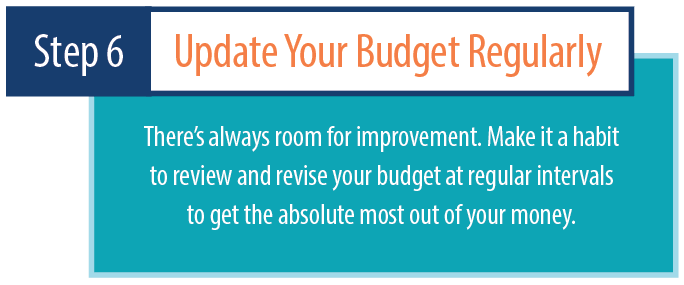
Review, Revise, Improve
Budgeting is a process. You make a budget, you live with it, you see what didn't work, and you try to do better the next time.
There are no rules for improving your budget. The only guideline should be your personal satisfaction. Are you happy with monthly money management? If not, why?
As you approach the budget revision process, here are a few helpful things to keep in mind.
Slash Expenses
Now that you've created a budget and are monitoring your expenses, give yourself a hearty pat on the back. You deserve it! If you find yourself overspending in a few categories, it's time to see where you can cut back on your expenses.
Aim for easy wins first. This are simple cuts, such as canceling a subscription you no longer need. For instance, if you have a gym subscription and also have passes for a local yoga studio, and find you are paying fewer visits to your gym, cancel the gym subscription. You can also spend an afternoon negotiating for lower rates on recurring expenses such as your cable or home internet bills.
Next, focus on big wins. Big wins include cutting back on categories that will net you the most savings. As your top three expenses are food, housing, and transportation, look for ways you can cut back on using your car, or maybe on how much you spend each week on groceries.
If you have time, hunt for discounts. Sometimes you may receive a small discount on your cellphone bill or AAA membership through your work, or by digging around online for promo codes.
Create Seasonal Budgets
Besides a main budget for your living expenses, it's helpful to create budgets for the holiday season or summer spending. That's because your spending most likely will peak during certain times of year, so you'll want to have a separate spending plan for these times of year.
Link Existing Habits With New Ones
If you're trying to create a new money habit, link it to an existing, well-formed one. For instance, if you drink a cup of coffee every morning before you go to work. And you want to be better about checking to see how much money you have left in your "safe to spend" account. So after you drink your cup of coffee, try logging in to your bank account, or use a money app, to check your balance.
Read more: How to Break Bad Money Habits
Set Dates to Review and Tweak
Just like how goals and values change, so should your budget. Whether you're happy with your budget or not, you should schedule a budget review regularly. How often is up to you. If you're just starting out, every couple months wouldn't be a bad idea. Once you're an old hand, you're probably fine reviewing things once a season or even once a year.
Get Help If You Need It
Now that you've received the lowdown on how to create a budget, it's time to get to work. If you're still unsure or uncomfortable with the idea of budgeting, help is available. MMI offers free budget counseling to anyone struggling to make ends meet. If you're having a hard time putting your finances in balance, a free counseling session is a great place to start.
Learn more about free budget counseling from MMI
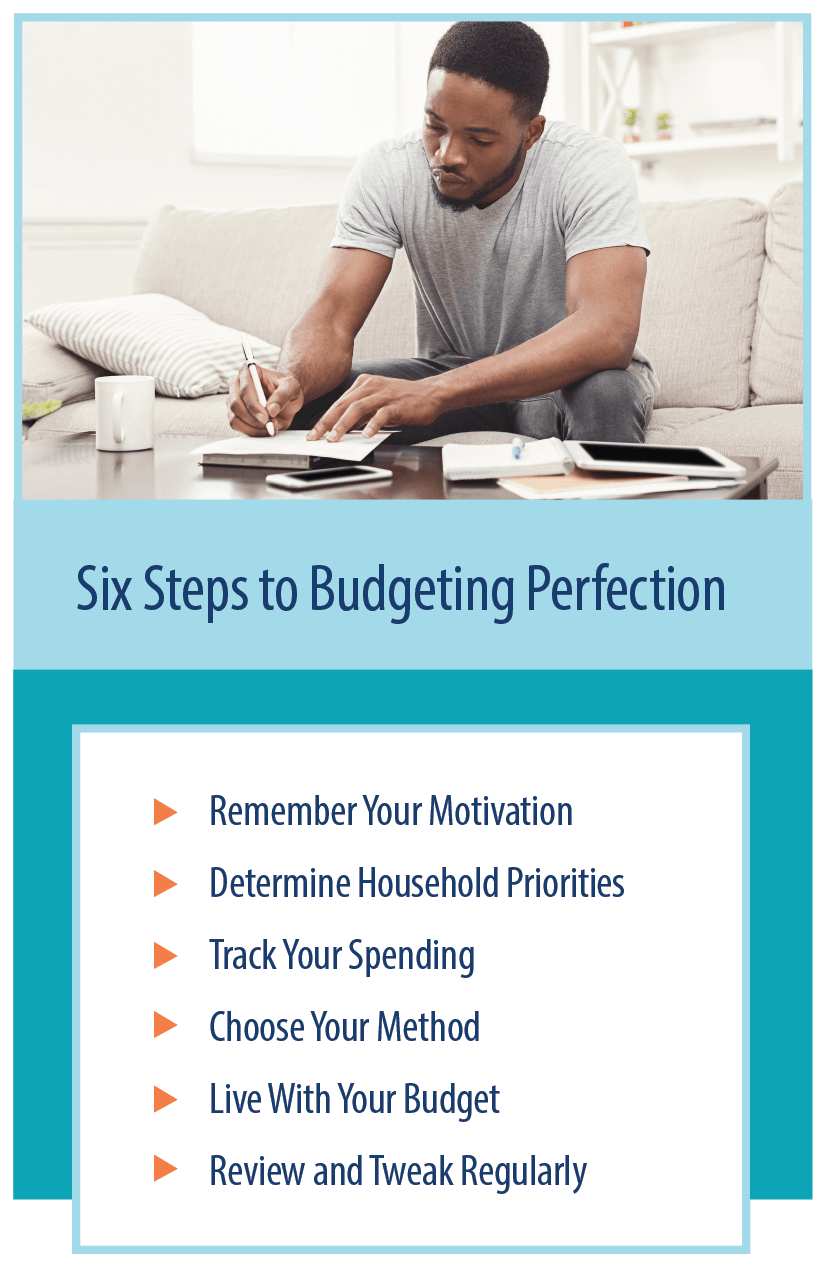
How To Create A Budget In Clarity Money
Source: https://www.moneymanagement.org/budget-guides/create-a-budget
Posted by: leclaircamigat.blogspot.com

0 Response to "How To Create A Budget In Clarity Money"
Post a Comment